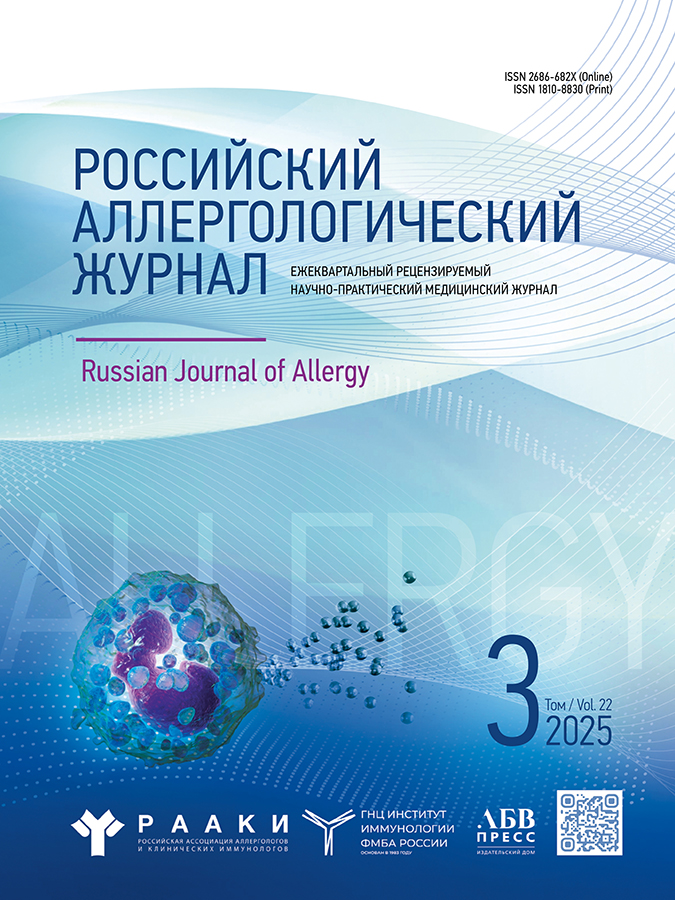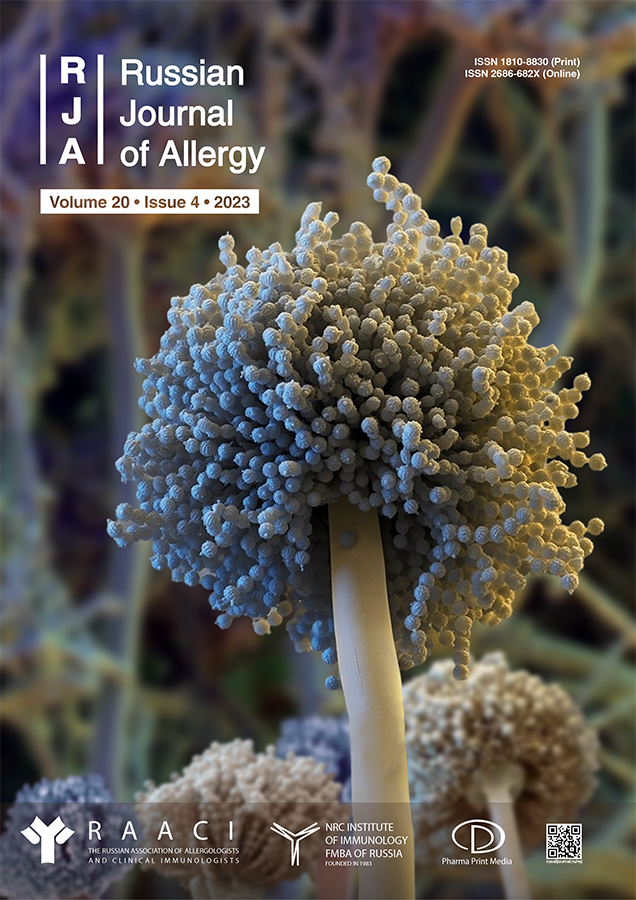Quantitative and species changes in the local microbiota of the upper respiratory tract in allergic rhinitis
- Authors: Tyurin Y.A.1,2, Sharifullina A.A.1,3, Reshetnikova I.D.1,3, Minnibayev R.A.1, Khairullin R.Z.1, Fassakhov R.S.3
-
Affiliations:
- Kazan Research Institute of Epidemiology and Microbiology
- Kazan State Medical University
- Kazan Federal University
- Issue: Vol 20, No 4 (2023)
- Pages: 476-487
- Section: Original studies
- Submitted: 24.07.2023
- Accepted: 30.11.2023
- Published: 02.12.2023
- URL: https://rusalljournal.ru/raj/article/view/14875
- DOI: https://doi.org/10.36691/RJA14875
- ID: 14875
Cite item
Abstract
BACKGROUND: The role of local microflora in the pathogenesis of allergic rhinitis has not been sufficiently studied; therefore, the study of changes in the nasal microbiome is of interest from a scientific and practical point of view.
AIM: To evaluate changes in the local microbiota of the nasal mucosa in patients with seasonal and year-round allergic rhinitis before and after pharmacological and allergen-specific therapy.
MATERIALS AND METHODS: An observational retrospective single-center case-control study was conducted, which included 182 patients with allergic rhinitis. The groups were randomized according to the diagnosis (seasonal and year-round allergic rhinitis) and the therapy used: basic pharmacotherapy and allergen-specific (sublingual) immunotherapy.
RESULTS: In total, 182 patients completed the study, of which 50 had seasonal allergic rhinitis, 51 had seasonal allergic rhinitis + atopic asthma (aged 7–42 years), and 81 had year-round allergic rhinitis, which included 29 aged 12–54 years and 52 with year-round allergic rhinitis + atopic asthma, aged 12–39 years. Patients with allergic rhinitis were divided into two subgroups: those who received basic therapy to achieve remission and those who received allergen-specific (sublingual) immunotherapy. After basic therapy, the abundance of Staphylococcus aureus in the local microbiota of the upper respiratory tract in patients with seasonal allergic rhinitis decreased by 1.4 times; in the allergen-specific (sublingual) immunotherapy group, its abundance more significantly decreased (3.9 times; p <0.05). In the group with year-round allergic rhinitis, the same pattern was noted. In the group with seasonal allergic rhinitis and year-round allergic rhinitis and the group with both allergen-specific (sublingual) immunotherapy and atopic asthma who received a full course of allergen-specific (sublingual) immunotherapy, the activation index of blood basophils by rSplA-proteinase S. aureus was reduced by 1.2–1.5 compared with the value in those who received basic pharmacotherapy.
CONCLUSION: Patients with allergic rhinitis exhibited quantitative and qualitative significant changes in the microbiome of the upper respiratory tract mucosa, one of the consequences of which is the development of IgE-mediated sensitization to S. aureus products. Allergen-specific immunotherapy for patients with allergic rhinitis leads to decreased colonization of the nasal mucosa with S. aureus and decreased sensitization to rSplA proteinase.
Keywords
Full Text
About the authors
Yury A. Tyurin
Kazan Research Institute of Epidemiology and Microbiology; Kazan State Medical University
Email: tyurin.yurii@yandex.ru
ORCID iD: 0000-0002-2536-3604
SPIN-code: 5089-5565
MD, Dr. Sci. (Med.)
Россия, Kazan; KazanAlsu A. Sharifullina
Kazan Research Institute of Epidemiology and Microbiology; Kazan Federal University
Email: alsusha74@mail.ru
ORCID iD: 0000-0003-2395-7377
MD, Cand. Sci. (Med.)
Россия, Kazan; KazanIrina D. Reshetnikova
Kazan Research Institute of Epidemiology and Microbiology; Kazan Federal University
Email: reshira@mail.ru
ORCID iD: 0000-0002-3584-6861
SPIN-code: 3255-0088
MD, Cand. Sci. (Med.), Associate Professor
Россия, Kazan; KazanRustam A. Minnibayev
Kazan Research Institute of Epidemiology and Microbiology
Email: rustam.md@mail.ru
ORCID iD: 0009-0003-3421-6221
Россия, Kazan
Ruslan Z. Khairullin
Kazan Research Institute of Epidemiology and Microbiology
Email: co1979@yandex.ru
ORCID iD: 0000-0002-4214-012X
SPIN-code: 7032-9137
Cand. Sci. (Biol.)
Россия, KazanRustem S. Fassakhov
Kazan Federal University
Author for correspondence.
Email: farrus@mail.ru
ORCID iD: 0000-0001-9322-2689
SPIN-code: 1748-7760
MD, Dr. Sci. (Med.), Professor
Россия, KazanReferences
- Polner SA. Federal clinical recommendations. Allergic rhinitis. Russ J Allergy. 2017;14(2):47–54. (In Russ). doi: 10.36691/RJA323
- Aït-Khaled N, Pearce N, Anderson HR, et al.; ISAAC Phase Three Study Group. Global map of the prevalence of symptoms of rhinoconjunctivitis in children: The international study of asthma and allergies in childhood (ISAAC) phase three. Allergy. 2009;64(1):123–148. doi: 10.1111/j.1398-9995.2008.01884.x
- Budikhina AS. Role of antimicrobial peptides in the pathology of upper respiratory tract diseases. Immunology. 2017;38(4):234–238. doi: 10.18821/0206-4952-2017-38-4-234-238
- Astafieva NG, Baranov AA, Vishneva EA, et al. Allergic rhinitis. Russ Rhinol. 2020;28(4):246–256. doi: 10.17116/rosrino202028041246
- Round JL, Mazmanian SK. The gut microbiota shapes intestinal immune responses during health and disease. Nat Rev Immunol. 2009;9(5):313–323. doi: 10.1038/nri2515
- Ohnmacht C, Park JH, Cording S, et al. Mucosal immunology. The microbiota regulates type 2 immunity through RORγt⁺ T cells. Science. 2015;349(6251):989–993. doi: 10.1126/science.aac42637
- Lal D, Keim P, Delisle J, et al. Mapping and comparing bacterial microbiota in the sinonasal cavity of healthy, allergic rhinitis, and chronic rhinosinusitis subjects. Int Forum Allergy Rhinol. 2017;7(6):561–569. doi: 10.1002/alr.21934
- Wang Y, Li X, Gu S, Fu J. Characterization of dysbiosis of the conjunctival microbiome and nasal microbiome associated with allergic rhinoconjunctivitis and allergic rhinitis. Front Immunol. 2023;20(14):1079154. doi: 10.3389/fimmu.2023.1079154
- Stepanov AS, Vasilyeva NV. New opportunities to identify and type Staphylococcus spp. by using Maldi-Tof mass spectrometry. Russ J Inf Immunity. 2018;8(4):489–496. doi: 10.15789/2220-7619-2018-4-489-496
- Bühring HJ, Streble A, Valent P. The basophil-specific ectoenzyme E-NPP3 (CD203c) as a marker for cell activation and allergy diagnosis. Int Arch Allergy Immunol. 2004;133(4):317–329. doi: 10.1159/000077351
- Kolata JB, Kühbandner I, Link C, et al. The fall of a dogma? Unexpected high T-cell memory response to Staphylococcus aureus in humans. J Infect Dis. 2015;212(5):830–838. doi: 10.1093/infdis/jiv128
- Zielinski CE, Mele F, Aschenbrenner D, et al. Pathogen-induced human Th17 cells produce IFN-γ or IL-10 and are regulated by IL-1β. Nature. 2012;484(26):514–518. doi: 10.1038/nature10957
Supplementary files







